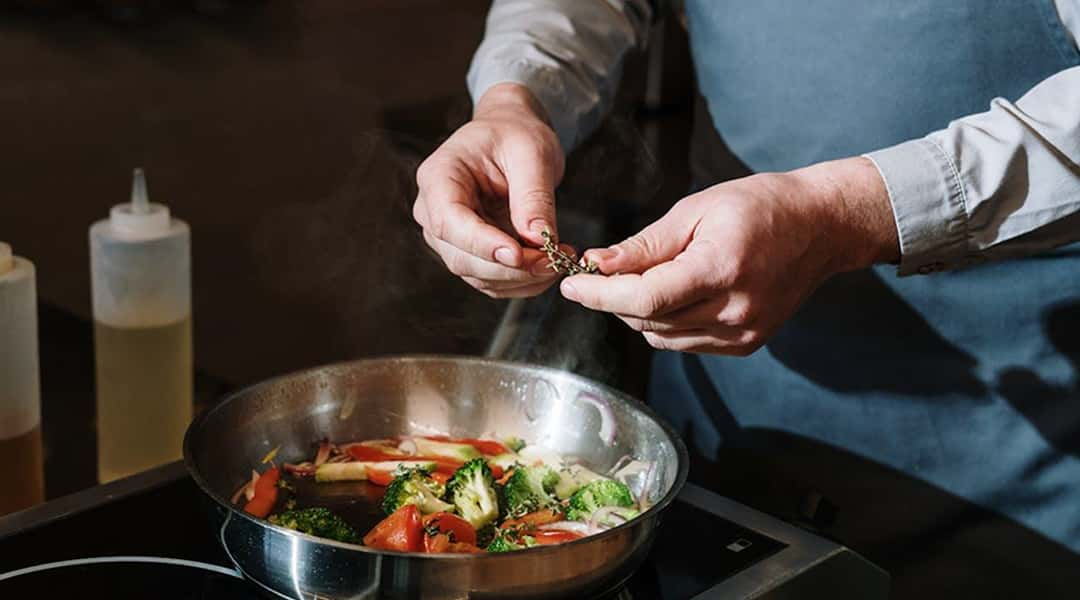European Style – Cracked Wheat & Veggie Pilaf

European-Style Cracked Wheat and Vegetable Pilaf (inspired by the South Indian recipe-Noruku Gothambu Uppumavu) is a delicious and wholesome dish that brings together cracked wheat (or bulgur), fresh vegetables, and aromatic spices in a warm, comforting bowl. Traditionally enjoyed in Indian homes as a breakfast or light meal, this recipe has been adapted to use locally available European ingredients. Packed with fibre, vitamins, and antioxidants, it’s perfect for those looking for a balanced, nourishing meal that satisfies both body and mind.
Ayurvedic Health Benefits:
In Ayurveda, cracked wheat is considered a “sattvic” food, meaning it promotes mental clarity and harmony in the body. The warming spices like mustard seeds and cumin aid digestion and stimulate metabolism, while the addition of fresh vegetables provides prana (vital life energy), which helps maintain balance and support the immune system. This dish is grounding and pacifying, particularly for Vata dosha, and can be enjoyed year-round for its comforting and restorative qualities.
Ideal as a nutritious breakfast or light meal, this recipe will leave you feeling energized and balanced, promoting both physical health and mental well-being.
European-Style Cracked Wheat and Veggie Pilaf Cooking Time: 25 mins
Ingredients:
● 1 cup cracked wheat (bulgur or freekeh works well as alternatives)
● 1 medium onion, finely chopped
● 1 small carrot, finely diced
● ½ cup green peas (fresh or frozen)
● 1 small bell pepper, diced (red or yellow for added color)
● 1 tsp mustard seeds
● 1 tsp cumin seeds
● 1-2 green chilies, chopped (or a small pinch of red chili flakes)
● 1-2 tbsp olive oil or sunflower oil
● A few fresh curry leaves (optional, or substitute with a sprig of rosemary or thyme for fragrance)
● Salt, to taste
● Freshly ground black pepper, to taste
● 2 cups water
Optional Garnishes:
● Fresh coriander or parsley, chopped
● A squeeze of lemon juice
Instructions:
1. Preparing the Cracked Wheat: Rinse the cracked wheat in cold water and drain. Set aside.
2. Sautéing the Aromatics: Heat the oil in a pan on medium heat. Add the mustard seeds, and once they start spluttering, add the cumin seeds and curry leaves (or rosemary/thyme for an aromatic touch). Sauté for a few seconds until fragrant.
3. Adding Vegetables: Add the chopped onions, and green chilies (or chili flakes), and sauté until the onions turn translucent. Add the carrots, peas, and bell pepper, and cook for 2-3 minutes until slightly softened.
4. Cooking the Cracked Wheat: Add the cracked wheat to the pan and toast it lightly for 1-2 minutes, mixing it with the vegetables.
5. Simmering: Pour in 2 cups of water, add salt, and stir well. Bring the mixture to a boil, then reduce the heat, cover, and let it simmer until the wheat absorbs the water and becomes soft (about 10-12 minutes). Stir occasionally to prevent sticking.
6. Final Touch: Once the water is absorbed and the wheat is cooked, remove from heat. Add black pepper, fresh coriander or parsley, and a squeeze of lemon juice if desired.
7. Serving: Serve warm, garnished with additional herbs or a side of yogurt for added creaminess.
Benefits of European-style Cracked Wheat and Veggie Pilaf:
1. Digestive Health:
Cracked wheat, like bulgur, is rich in fiber, aiding digestion and promoting a feeling of fullness. The addition of cumin and black pepper also supports digestion; cumin helps reduce bloating and discomfort, while black pepper stimulates digestive enzymes, improving nutrient absorption.
2. Balances Blood Sugar:
Cracked wheat provides a steady release of energy, thanks to its complex carbohydrates. This, combined with fiber, makes the dish ideal for those managing blood sugar levels and energy balance.
3. Anti-Inflammatory Boost:
Cumin and black pepper both have anti-inflammatory properties. Black pepper contains piperine, which enhances nutrient absorption and combats inflammation, while cumin supports the body’s natural detoxification processes.
4. Immunity and Antioxidants:
With the vegetables, cumin, and black pepper, this dish is high in antioxidants, which support the immune system and protect cells from free radical damage.
5. Supports Heart Health:
Olive oil and black pepper contribute beneficial fats and antioxidants that are supportive of cardiovascular health, promoting circulation and lowering inflammation.
We believe in collaborative relationship-based care where our Ayurvedic Doctors, Ayurvedic Practitioner, Ayurvedic Supplement Brands, Ayurvedic Nutritionists & Chefs, Yoga, and Meditation Trainers are in sync. Contact the team who passionately works together to hold your hand in this healing journey.
